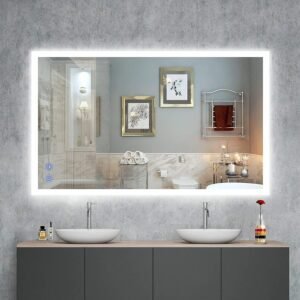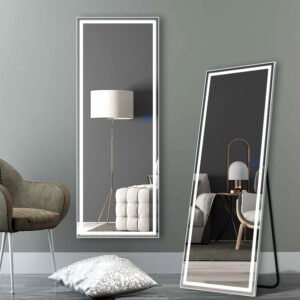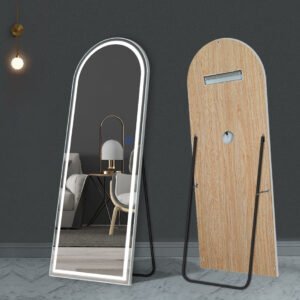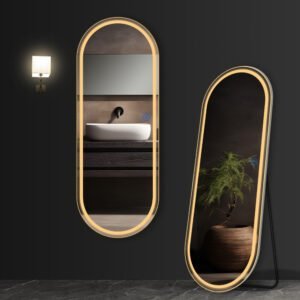Struggling to mount a mirror securely? How to stick mirror to wall? The improper method might result in accidents, wall damage, or an insecure bathroom mirror. Learn the best procedures for installing and securing your mirror with lights.
To properly mount a mirror, start by cleaning the surface, choosing the right mirror adhesive, and allowing proper drying time. If installing a miroir de vanité avec des lumières, ensure the wall can support its weight. Bathroom mirror glue or stick mirror to wall with silicone are common solutions. Follow these steps for a safe and long-lasting installation.
We’ve included professional advice on how to choose adhesives, prepare walls, and keep your led bathroom mirror firmly in place.

Table des matières
BasculerHow to Choose the Right Adhesive?
Choosing the right glue to hang mirror is crucial. The incorrect glue may cause the mirror to fall, break, or harm the wall. Different adhesives perform better on various surfaces and mirror kinds.
For lightweight miroirs illuminés, double-sided sticky tape may suffice. For heavier led mirrors, a strong mirror adhesive like bathroom mirror glue or liquid nails is recommended. Using a high-quality adhesive to hang the mirror assures longevity and a tight grip.
The type of mirror adhesive used is determined by the weight of the miroir rétro-éclairé and the surface. LED mirrors manufacturers propose using silicone to attach the mirror to the wall for long-term stability. LED mirror suppliers frequently employ bathroom mirror adhesive to secure mirror LED light bathroom installations. When installing a Bluetooth mirror, make sure the glue is strong enough to hold both the mirror and the electronic components within.

How Does Wall Type Affect Adhesion?
The kind of wall surface has a considerable impact on how effectively a mirror with LED lights stays in place. Porous, rough, or brittle walls may require more support than merely glue.
Smooth surfaces, such as tiles or polished drywall, offer the best adherence for Miroirs de salle de bain LED. Drywall may require anchors in addition to mirror adhesive. Hanging heavy mirror on drywall without sufficient bracing may cause damage or instability.
The optimum surface for a back lit mirror is one that is clean and non-porous. When mounting cosmetic light mirrors to drywall, LED mirror manufacturers recommend using a mix of adhesive and mechanical fasteners. Installing a vanity mirror with LED lights on textured walls may necessitate sanding or smoothing the surface for proper adherence.

How to Prepare the Wall Before Installation?
Proper wall preparation guarantees that your light up cosmetic mirror adheres properly and stays stable over time. Before applying adhesive to attach a mirror, scrub the wall with alcohol or a light detergent to eliminate dust and oil. When attaching a bathroom mirror with lights, make sure the surface is dry and smooth for the optimum adherence.
An LED vanity mirror should be mounted on a clean, firm surface. LED mirror suppliers advise monitoring for moisture concerns, especially when installing a mirror bathroom with light in a humid climate. When applying mirror glue to a painted wall, gently sanding the surface may help attach. LED mirror manufacturers advise against installing a miroir rétro-éclairé on freshly painted walls because paint might impair adherence.

What Are the Steps for Proper Mirror Installation?
Following the proper installation methods prevents mishaps and guarantees that your light up mirror stays firmly in place for years. Apply mirror adhesive evenly to the back of the led light mirror vanity, pressing it firmly against the wall and using temporary supports while the glue cures. Large wall mirrors with lights may need additional brackets for stability.
Avoid using too much glue on a Miroir de maquillage LED since it may ooze out of the edges. When installing a makeup vanity mirror with lights, consider utilizing mounting brackets instead of glue to hang the mirror. LED mirror suppliers recommend waiting at least 24 hours for the glue to fully dry before removing temporary supports.

How to Ensure Mirror Stays Secure After Installation?
Even after installation, a back lighted mirror may slip or loosen with time. Regular inspections and reinforcements assist to preserve stability. Avoid touching or modifying a light up vanity mirror for at least 24 hours after installation. Gently push on the edges to test their stability. If a magnifying mirror with light becomes loose, fix with more mirror adhesive.
LED mirror manufacturers recommend that you check the installation of vanity LED lights for mirror every few months. If a Bluetooth mirror begins to shift, reapply bathroom mirror adhesive along the borders. Placing an illuminated mirror in a high-traffic location raises the chance of separation, therefore extra caution should be exercised.

How to Safely Remove a Stuck Mirror?
When it comes to removing a bathroom mirror with lights, following the proper procedure saves wall damage and assures safety. Use a heat gun or dental floss to remove the mirror’s glue. Carefully peel the illuminated mirrors away from the wall to avoid fractures. Remove any remaining residue with an adhesive remover.
Applying heat to a LED cosmetic mirror weakens the bathroom mirror adhesive, making it easier to remove. To prevent wall damage, LED mirror suppliers advocate utilizing plastic tools rather than metal scrapers. When removing a miroir de salle de bain rétro-éclairé, have a second person support it to avoid unexpected drops.

Are Most Mirrors Glued to the Wall?
Many people question if mirrors with LED lights are attached with glue, brackets, or screws. Some cosmetic light mirrors are affixed to the wall, while others use mechanical fastening. The decision is based on the weight, taille, and wall material.
LED mirror factories frequently opt to glue LED mirrors to walls using silicone for a clean appearance. A light up bathroom mirror or Miroir pleine longueur avec lumières may include built-in mounting brackets. A Bluetooth mirror requires tight installation in order to accommodate additional devices.

Where Should You Not Put Mirrors in Your House?
In certain cultures, improperly placed illuminated mirrors can cause pain, poor aesthetics, and even negative energy flow. Avoid placing bright mirrors opposite beds, crowded areas, or intense lighting sources since they might produce glare and upset the room’s equilibrium.
A backlit bathroom mirror should not be positioned in direct sunlight since it may cause excessive glare. LED vanity mirrors placed in untidy places might visually accentuate disarray. To avoid vibration damage, LED mirror suppliers recommend that wall mirrors with lights be placed away from often slammed doors.
Résumé
The proper installation of a bathroom mirror with lights assures stability and safety. Following these rules will allow you to properly place your vanity mirror with lights while ensuring long-term durability.










